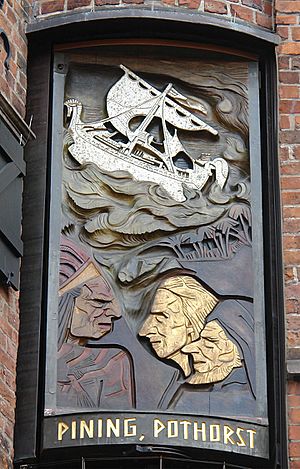Didrik Pining facts for kids

Didrik Pining (born around 1430 – died 1491) was a German privateer and a nobleman. A privateer was like a legal pirate, working for a country. He also served as a governor in Iceland and at Vardøhus Fortress.
Some historians, like Sofus Larsen, believe he might have landed in North America in the 1470s. This would be almost 20 years before Christopher Columbus's famous voyages. However, many of these claims about Pining are debated. This is because there isn't a lot of information about him, and some of it doesn't quite match up.
Contents
Biography
Early Life and Career
Didrik Pining was born in Hildesheim, a city in Germany. For a long time, people thought he was from Denmark or Norway. But in the 1930s, new research proved he was German.
Before 1468, Pining worked for the city of Hamburg. He was a captain and privateer. His job was to hunt down English merchant ships in the North Atlantic.
From 1468 to 1478, he worked for Denmark. By 1470, he was even an "admiral." He served under King Christian I of Denmark and later his son, John of Denmark. Before working for Denmark, Pining and his friend Hans Pothorst were seen as "pirates" by the Hanseatic League. The Hanseatic League was a powerful group of trading cities. Pining and Pothorst caused a lot of trouble for these cities. But later, under King Christian I, they became known as skilled sailors and brave adventurers.
Did Pining Sail to America?
Sofus Larsen's Idea
The idea that Pining reached America was first shared by Dr. Sofus Larsen in 1925. He was a professor at the University of Copenhagen. Larsen wrote a book called The Discovery of North America Twenty Years Before Columbus.
Larsen based his ideas on several old records that seemed unrelated. He believed Pining led an expedition towards Greenland in the early 1470s. Pining was supposedly joined by Hans Pothorst, and two Portuguese explorers, João Vaz Corte-Real and Álvaro Martins. The navigator for this trip was said to be a mysterious figure named John Scolvus.
According to Larsen, the journey likely started from Bergen, went to Iceland, then Greenland. Finally, they supposedly found Terra do Bacalhau, which means "Land of Codfish." This land is now thought to be Newfoundland or Labrador. Larsen believed Pining and Corte-Real were rewarded for this discovery. Pining became governor of Iceland in 1478, and Corte-Real became governor of the Azores in 1474.
What Research Says
Larsen's claims were very popular in Scandinavia and Portugal. However, German scholars often disagreed with them. Historians in America and England had mixed reactions. Some made fun of the idea, while others thought parts of it could be true.
Many things seem to support the theory, but it's still "not proven." There isn't enough clear evidence to say for sure. No old records directly say that Pining and Pothorst sailed with Corte-Real. Also, no records clearly state they reached North America (other than Greenland).
However, we do know that Pining and Pothorst were sent by the Danish king on a special mission. They were to explore trade options in Iceland. Pining was also told to look for the "neighboring regions" (regiones finitimae). These were old Norse settlements in Greenland from the 11th century. In 1476, they made this trip. They likely went to Greenland and met Inuit people who were not friendly. They did not find any Norse people there. Some think they visited a place called Angmagssalik. There is nothing to suggest they went further west than this.
Later Years and Death
In 1478, Didrik Pining became the governor (höfuðsmaðr) of Iceland. He served until 1481. He was replaced by Thorleif Björnsson. Later, Thorleif gave Pining silver and a walrus ivory horn. This was to pay the king for a special license for his family. This agreement helped join two of Iceland's most powerful families in 1484.
In 1481, Pining attended the funeral of Danish King Christian I. He also visited Bergen and Copenhagen to show his respect. He was made a knight in Norway. His personal coat of arms had a grappling hook on it. A few years later, in 1489 and 1490, he was again called "governor (hirdstjore) over the whole of Iceland." This was in two Icelandic laws, known as Pining's Laws. An old writer said Pining "was a helpful man and fixed many things that were wrong." His godson and nephew, Didrik Pining the Younger, took over as governor in 1490. He served for two years.
Pining and Hans Pothorst also patrolled the North Atlantic. They played important roles in the Anglo-Danish Naval War (1484–90). Around 1484, Pining captured three Spanish or Portuguese ships near England or France. He brought them to King John of Denmark in Copenhagen. In 1486, he went with King John to Bergen as the admiral of the royal fleet. In 1487, he led a fleet to the island of Gotland in the Baltic Sea. He made sure Denmark controlled it.
In 1490, Denmark made a peace agreement with the Dutch. But it clearly stated that Didrik Pining and another admiral were not included in the peace. He was also called a lord of Iceland. In the same year, Pining became governor of Vardøhus Fortress. This meant he was likely the main commander of the seas and lands in the northern areas.
Didrik Pining probably died, or was possibly killed, around Finnmark or the North Cape in 1491.
See also
 In Spanish: Didrik Pining para niños
In Spanish: Didrik Pining para niños

